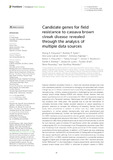| dc.contributor.author | Ferguson, Morag E. | |
| dc.contributor.author | Eyles, Rodney P. | |
| dc.contributor.author | Oliveira, Ana Luísa Garcia- | |
| dc.contributor.author | Kapinga, Fortunus | |
| dc.contributor.author | Masumba, Esther A. | |
| dc.contributor.author | Amuge, Teddy | |
| dc.contributor.author | Bredeson, Jessen V. | |
| dc.contributor.author | Rokhsar, Daniel S. | |
| dc.contributor.author | Lyons, Jessica B. | |
| dc.contributor.author | Shah, Trushar | |
| dc.contributor.author | Rounsley, Steve | |
| dc.contributor.author | Mkamilo, Geoffrey | |
| dc.date.accessioned | 2023-11-22T14:20:27Z | |
| dc.date.available | 2023-11-22T14:20:27Z | |
| dc.date.issued | 2023-11-03 | |
| dc.identifier.uri | https://doi.org/10.3389/fpls.2023.1270963 | |
| dc.identifier.uri | https://www.frontiersin.org/articles/10.3389/fpls.2023.1270963/full#:~:text=Upregulation%20of%20key%20genes%20in,in%20the%20CBSD%2Dresistant%20landrace. | |
| dc.identifier.uri | http://ir-library.mmust.ac.ke:8080/xmlui/handle/123456789/2407 | |
| dc.description.abstract | Cassava (Manihot esculenta Crantz) is a food and industrial storage root crop with substantial potential to contribute to managing risk associated with climate change due to its inherent resilience and in providing a biodegradable option in manufacturing. In Africa, cassava production is challenged by two viral diseases, cassava brown streak disease (CBSD) and cassava mosaic disease. Here we detect quantitative trait loci (QTL) associated with CBSD in a biparental mapping population of a Tanzanian landrace, Nachinyaya and AR37-80, phenotyped in two locations over three years. The purpose was to use the information to ultimately facilitate either marker-assisted selection or adjust weightings in genomic selection to increase the efficiency of breeding. Results from this study were considered in relation to those from four other biparental populations, of similar genetic backgrounds, that were phenotyped and genotyped simultaneously. Further, we investigated the co-localization of QTL for CBSD resistance across populations and the genetic relationships of parents based on whole genome sequence information. Two QTL on chromosome 4 for resistance to CBSD foliar symptoms and one on each of chromosomes 11 and 18 for root necrosis were of interest. Of significance within the candidate genes underlying the QTL on chromosome 4 are Phenylalanine ammonia-lyase (PAL) and Cinnamoyl-CoA reductase (CCR) genes and three PEPR1-related kinases associated with the lignin pathway. In addition, a CCR gene was also underlying the root necrosis-resistant QTL on chromosome 11. Upregulation of key genes in the cassava lignification pathway from an earlier transcriptome study, including PAL and CCR, in a CBSD-resistant landrace compared to a susceptible landrace suggests a higher level of basal lignin deposition in the CBSD-resistant landrace. Earlier RNAscope® in situ hybridisation imaging experiments demonstrate that cassava brown streak virus (CBSV) is restricted to phloem vessels in CBSV-resistant varieties, and phloem unloading for replication in mesophyll cells is prevented. The results provide evidence for the involvement of the lignin pathway. In addition, five eukaryotic initiation factor (eIF) genes associated with plant virus resistance were found within the priority QTL regions. | en_US |
| dc.language.iso | en | en_US |
| dc.publisher | Frontiers in Plant Science | en_US |
| dc.subject | Candidate, genes,field, resistance,cassava, brown, streak, disease, revealed, analysis, multiple, data, sources | en_US |
| dc.title | Candidate genes for field resistance to cassava brown streak disease revealed through the analysis of multiple data sources | en_US |
| dc.type | Article | en_US |

